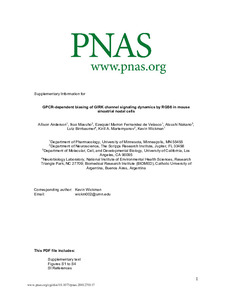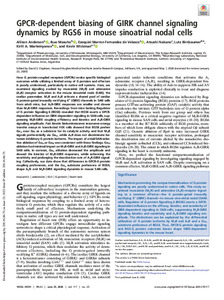Por favor, use este identificador para citar o enlazar este ítem:
https://repositorio.uca.edu.ar/handle/123456789/14237| Campo DC | Valor | Lengua/Idioma |
|---|---|---|
| dc.contributor.author | Anderson, Allison | es |
| dc.contributor.author | Masuho, Ikuo | es |
| dc.contributor.author | Marrón Fernández de Velasco, Ezequiel | es |
| dc.contributor.author | Nakano, Atsushi | es |
| dc.contributor.author | Birnbaumer, Lutz | es |
| dc.contributor.author | Martemyanov, Kirill A. | es |
| dc.contributor.author | Wickman, Kevin | es |
| dc.date.accessioned | 2022-06-23T15:23:13Z | - |
| dc.date.available | 2022-06-23T15:23:13Z | - |
| dc.date.issued | 2020 | - |
| dc.identifier.citation | Anderson, A., et al. GPCR-dependent biasing of GIRK channel signaling dynamics by RGS6 in mouse sinoatrial nodal cells [en línea]. Proceedings of the National Academy of Sciences (PNAS). 2020, 117(25) doi:10.1073/pnas.2001270117 Disponible en: https://repositorio.uca.edu.ar/handle/123456789/14237 | es |
| dc.identifier.issn | 0027-8424 (impreso) | - |
| dc.identifier.issn | 1091-6490 (online) | - |
| dc.identifier.uri | https://repositorio.uca.edu.ar/handle/123456789/14237 | - |
| dc.description.abstract | Abstract: How G protein-coupled receptors (GPCRs) evoke specific biological outcomes while utilizing a limited array of G proteins and effectors is poorly understood, particularly in native cell systems. Here, we examined signaling evoked by muscarinic (M2R) and adenosine (A1R) receptor activation in the mouse sinoatrial node (SAN), the cardiac pacemaker. M2R and A1R activate a shared pool of cardiac G protein-gated inwardly rectifying K+ (GIRK) channels in SAN cells from adult mice, but A1R-GIRK responses are smaller and slower than M2R-GIRK responses. Recordings from mice lacking Regulator of G protein Signaling 6 (RGS6) revealed that RGS6 exerts a GPCRdependent influence on GIRK-dependent signaling in SAN cells, suppressing M2R-GIRK coupling efficiency and kinetics and A1R-GIRK signaling amplitude. Fast kinetic bioluminescence resonance energy transfer assays in transfected HEK cells showed that RGS6 prefers Gαo over Gαi as a substrate for its catalytic activity and that M2R signals preferentially via Gαo, while A1R does not discriminate between inhibitory G protein isoforms. The impact of atrial/SAN-selective ablation of Gαo or Gαi2 was consistent with these findings. Gαi2 ablation hadminimal impact onM2R-GIRK and A1R-GIRK signaling in SAN cells. In contrast, Gαo ablation decreased the amplitude and slowed the kinetics of M2R-GIRK responses, while enhancing the sensitivity and prolonging the deactivation rate of A1R-GIRK signaling. Collectively, our data show that differences in GPCR-G protein coupling preferences, and the Gαo substrate preference of RGS6, shape A1R- and M2R-GIRK signaling dynamics in mouse SAN cells. | es |
| dc.format | application/pdf | es |
| dc.language.iso | eng | es |
| dc.publisher | National Academy of Sciences | es |
| dc.rights | Acceso abierto | * |
| dc.rights.uri | http://creativecommons.org/licenses/by-nc-sa/4.0/ | * |
| dc.source | Proceedings of the National Academy of Sciences (PNAS). 2020, 117(25) | es |
| dc.subject | RITMO CARDIACO | es |
| dc.subject | Kir3 | es |
| dc.subject | ADENOSINA | es |
| dc.title | GPCR-dependent biasing of GIRK channel signaling dynamics by RGS6 in mouse sinoatrial nodal cells | es |
| dc.type | Artículo | es |
| dc.identifier.doi | 10.1073/pnas.2001270117 | - |
| dc.identifier.pmid | 32513692 | - |
| uca.disciplina | MEDICINA | es |
| uca.issnrd | 1 | es |
| uca.affiliation | Fil: Anderson, Allison. University of Minnesota. Department of Pharmacology; Estados Unidos | es |
| uca.affiliation | Fil: Masuho, Ikuo. The Scripps Research Institute, Department of Neuroscience; Estados Unidos | es |
| uca.affiliation | Fil: Marrón Fernández de Velasco, Ezequiel. University of Minnesota. Department of Pharmacology; Estados Unidos | es |
| uca.affiliation | Fil: Nakano, Atsushi. University of California. Department of Molecular, Cell, and Developmental Biology; Estados Unidos | es |
| uca.affiliation | Fil: Birnbaumer, Lutz. National Institute of Environmental Health Sciences. Neurobiology Laboratory; Estados Unidos | es |
| uca.affiliation | Fil: Birnbaumer, Lutz. Pontificia Universidad Católica Argentina. Facultad de Ciencias Médicas. Instituto de Investigaciones Biomédicas; Argentina | es |
| uca.affiliation | Fil: Martemyanov, Kirill A. The Scripps Research Institute, Department of Neuroscience; Estados Unidos | es |
| uca.affiliation | Fil: Wickman, Kevin. University of Minnesota. Department of Pharmacology; Estados Unidos | es |
| uca.version | publishedVersion | es |
| item.grantfulltext | open | - |
| item.fulltext | With Fulltext | - |
| item.languageiso639-1 | en | - |
| crisitem.author.dept | Instituto de Investigaciones Biomédicas - BIOMED | - |
| crisitem.author.dept | Laboratorio de Función y Farmacología de Canales Iónicos | - |
| crisitem.author.dept | Consejo Nacional de Investigaciones Científicas y Técnicas | - |
| crisitem.author.dept | Facultad de Ciencias Médicas | - |
| crisitem.author.orcid | 0000-0002-0775-8661 | - |
| crisitem.author.parentorg | Facultad de Ciencias Médicas | - |
| crisitem.author.parentorg | Instituto de Investigaciones Biomédicas - BIOMED | - |
| crisitem.author.parentorg | Pontificia Universidad Católica Argentina | - |
| Aparece en las colecciones: | Artículos | |
Ficheros en este ítem:
| Fichero | Descripción | Tamaño | Formato | |
|---|---|---|---|---|
| pnas.2001270117.sapp.pdf | Material suplementario | 422,38 kB | Adobe PDF |  Visualizar/Abrir |
| GPCR-dependent biasing.pdf | 1,71 MB | Adobe PDF |  Visualizar/Abrir |
Visualizaciones de página(s)
31
comprobado en 27-abr-2024
Descarga(s)
45
comprobado en 27-abr-2024
Google ScholarTM
Ver en Google Scholar
Altmetric
Altmetric
Este ítem está sujeto a una Licencia Creative Commons

